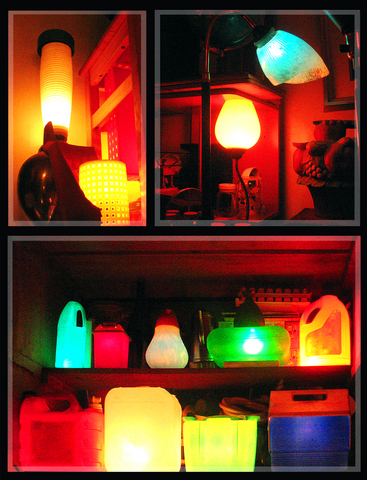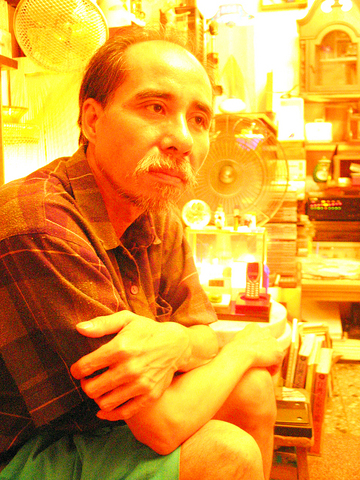Tsai Lin (
Although transforming used plastic, bottles, jars and toys into table lamps has earned him praise from the local fashion scene, in addition to a few magazines and newspapers articles, Tsai struggles to pay the rent for his small shop. Like any designer, he hopes to someday see his logo on lamps sold around the world. In the meantime, he is realistic about such ambitions and he also sells secondhand furniture and and other items.
Not formally trained as an artist, Tsai considers himself an entrepreneur. Before investing all his savings into his lamp business five years ago, he ran a coffee shop and sold paintings from local artists. His first attempt at manufacturing and selling lamps was run from a combined coffee and tea store, but as the volume of secondhand merchandise increased, the tables were removed.

PHOTOS: DIANA FREUNDL, TAIPEI TIMES
It's a shame to see Tsai's talent buried amongst the secondhand bags and toys, but until the public is enlightened about the potential for refuse material the clutter is necessary to make ends meet, he said.
"More people have shown an interest in vintage furniture and ornaments but lamps made from empty cleaning pro-duct bottles, are still unusual to most people."
The general public could also use a few lessons on appropriate lighting, according to Tsai, who claimed it was the most overlooked aspect of a living space. "Most people don't use suitable lighting. Florescent bulbs are fine for the office, but unacceptable in a home," he said recommending four or five light sources per room.

Lamps can be subdivided into those for ambiance (to illuminate a room), those for work (for reading) and those for mood (to provide an accent). Many homes have replaced glaring overhead lights with dimmers and softer bulbs, but few take into consideration the importance of good mood lighting, which can add a sense of style to the room, Tsai said.
His lamps use 10-watt to 20-watt bulbs so they are ill-suited for work lighting, but they are economical and fun. He divides his products into two types: those focusing on color and those in which shape, pattern or size is most significant. The former are made from empty plastic containers and colored bulbs, while the latter include toys, baskets and glass jars, all of which use white bulbs and create shadow effects on the wall.
Utilizing recycled materials makes Tsai's designs one-of-a-kind, but it also limits the amount of mass-production he can do. He has patented a logo -- KTWF -- which is written on every piece, but he is keen to license out the copyright to interested companies. So far, his requests have been from students eager to learn the trade.

"Ideally I would like to have two lines -- one for consumer use and a separate line for design exhibitions," he said.
Tsai has difficultly reaching the mainstream consumer due to his poor location. Though located only minutes from the central shopping district of Zhongxiao, apart from visitors on their way to Shenkeng (
Dependent upon word of mouth, Tsai said most of his clientele are from the film, fashion and arts communities. During our interview, a regular costumer and admirer dropped by with his two adult children. Zhen Lian-zhi (
Tsai's prices begin at NT$300 and continue upward to NT$3,000, depending on materials. He says the use of re-cycled materials keeps production costs low. He also takes costumer orders for those who have a particular idea in mind.
"If there is a way, I will convert it into a lamp," he said.
Tsai Lin's Store (

On April 26, The Lancet published a letter from two doctors at Taichung-based China Medical University Hospital (CMUH) warning that “Taiwan’s Health Care System is on the Brink of Collapse.” The authors said that “Years of policy inaction and mismanagement of resources have led to the National Health Insurance system operating under unsustainable conditions.” The pushback was immediate. Errors in the paper were quickly identified and publicized, to discredit the authors (the hospital apologized). CNA reported that CMUH said the letter described Taiwan in 2021 as having 62 nurses per 10,000 people, when the correct number was 78 nurses per 10,000

As we live longer, our risk of cognitive impairment is increasing. How can we delay the onset of symptoms? Do we have to give up every indulgence or can small changes make a difference? We asked neurologists for tips on how to keep our brains healthy for life. TAKE CARE OF YOUR HEALTH “All of the sensible things that apply to bodily health apply to brain health,” says Suzanne O’Sullivan, a consultant in neurology at the National Hospital for Neurology and Neurosurgery in London, and the author of The Age of Diagnosis. “When you’re 20, you can get away with absolute

May 5 to May 11 What started out as friction between Taiwanese students at Taichung First High School and a Japanese head cook escalated dramatically over the first two weeks of May 1927. It began on April 30 when the cook’s wife knew that lotus starch used in that night’s dinner had rat feces in it, but failed to inform staff until the meal was already prepared. The students believed that her silence was intentional, and filed a complaint. The school’s Japanese administrators sided with the cook’s family, dismissing the students as troublemakers and clamping down on their freedoms — with

As Donald Trump’s executive order in March led to the shuttering of Voice of America (VOA) — the global broadcaster whose roots date back to the fight against Nazi propaganda — he quickly attracted support from figures not used to aligning themselves with any US administration. Trump had ordered the US Agency for Global Media, the federal agency that funds VOA and other groups promoting independent journalism overseas, to be “eliminated to the maximum extent consistent with applicable law.” The decision suddenly halted programming in 49 languages to more than 425 million people. In Moscow, Margarita Simonyan, the hardline editor-in-chief of the